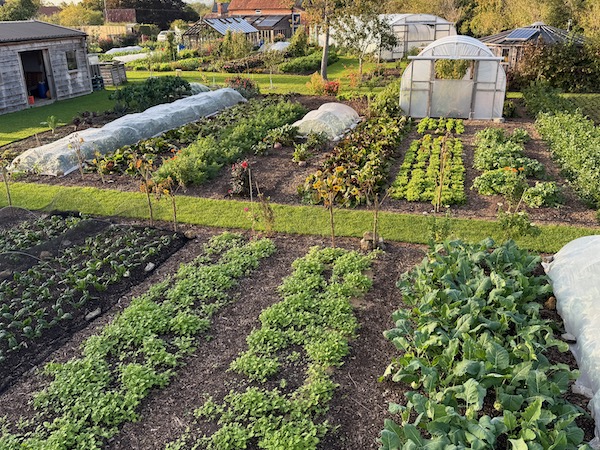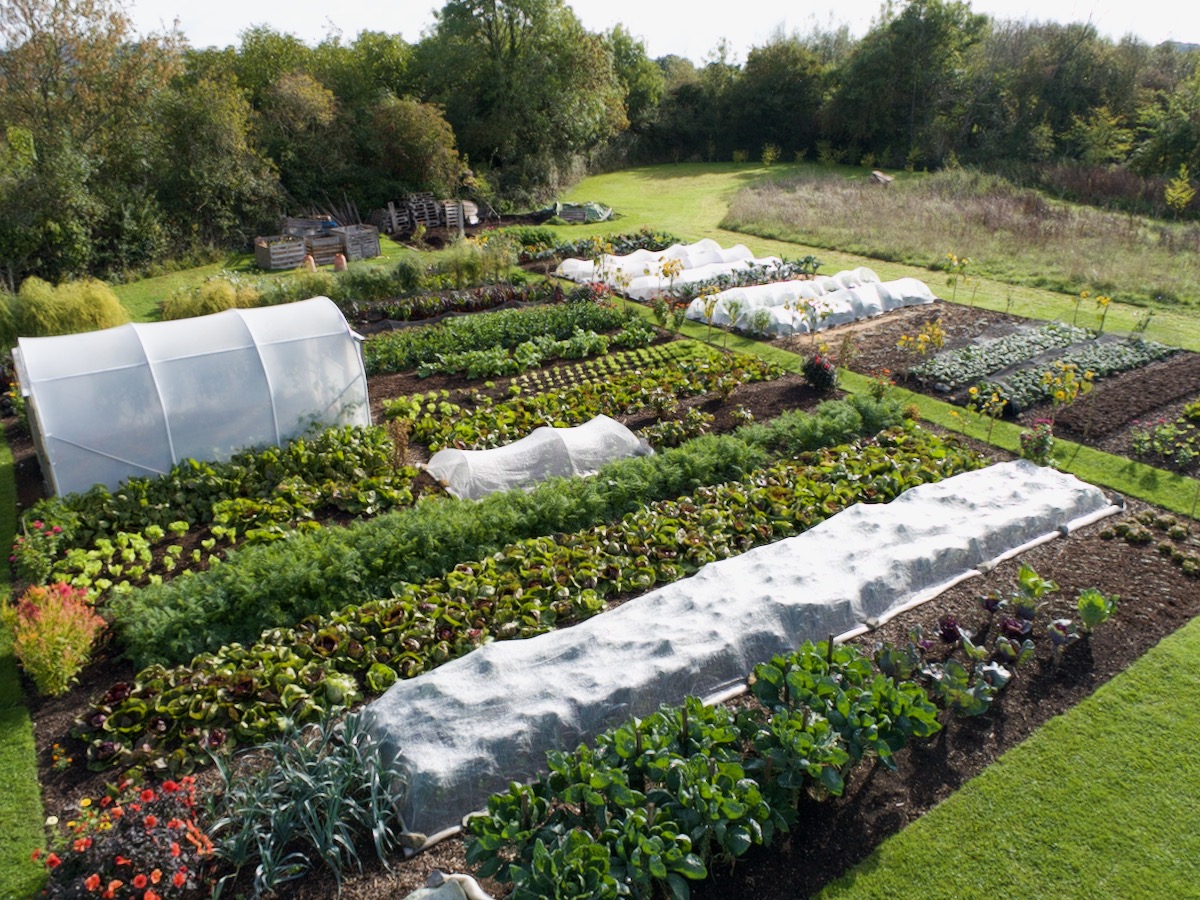
ABOVE Composts of different textures and colours.
From left to right are 1 my own compost, 2 wood chip of light colour which is three years old, 3 one year wood chip at the back, 4 one year old worm compost (wormcasts) on the right.
Potting mix
For potting, all of the compost above are suitable. If you've not made your own mix before, do have a look at this video.
If you do not have enough of your own materials to make a mix, I recommend Urban Wyrm peat free, which is 30% worm casts and gives me good results. It's not the cheapest, but the strong growth justifies that in my experience.
With a good compost mix, there is no need to do any feeding. That would be a supplementary job, and is an extra expense.
- You need to feed if using a coir compost, because coir contains almost no nutrients.
- Likewise for composts based on digestate, which have given me poor results. Read the small print on a sack, to see their origin.

Multisow
Many plants like to grow in clumps. Plus multisowing saves time, space, and compost. It's suitable now for radish, turnips, spinach, onions, salad onions, Florence fennel, salad rocket (arugula, and before end-February), peas for shoots, beetroot, and dill. See my webpage for details of seed numbers for each vegetable.
Because you can grow more plants in the same space, it’s feasible to grow more early crops of, say, turnips and radish. This applies especially at this time, when warmth for propagating is scarce and precious, in February and early March.
Then the harvests of radish and turnips in April and May are welcome, as ‘hungry gap’ vegetables, when fresh food is scarce and expensive. After those harvests, there is time to clear the space before planting summer beans, courgettes, brassicas and more. Starting early is a win-win.

Heat and light for seeds and seedlings
Germination requires extra warmth, compared to what is needed by seedlings once germinated. Even in a greenhouse, night temperatures are often low enough to prevent germination. Seeds are programmed not to germinate before it's warm enough. I recommend to invest in an electric heat mat.
Or if you have the space and the materials needed, make a hotbed as below. My video has the details.
Additional light is necessary only if you want to grow seedlings in the warmth of your house. Not for the germination phase.
I bring newly sown trays into my conservatory, or any warm room. But once leaves appear, unless you move seedlings to full light such as greenhouse or coldframe, extra light is required. Otherwise, seedlings grow long legs, another way of saying the stems are thin and weak.
I am trialling a few electric light devices, and cannot give details yet.

SOW NOW
My sowing schedule is for a mild temperate climate. I expect more frosts, but what we sow at this time of year is cold resistant. Like, I don't sow tomatoes until mid March.
- With warmth, you can sow aubergine, pepper and chilli, because they take longer than tomatoes.
Sow any of broad (fava) beans, peas (for shoots in particular), spinach, lettuce, onions, salad, onions, cabbage, calabrese, kohlrabi, cauliflower, turnips, radish and Florence fennel.
Sow parsley, coriander and dill.
Plus an early sowing of celery can be worthwhile, to grow under cover especially. Leave celery seeds on the surface as they need light to germinate – cover with glass to retain moisture.
It's too early to sow celeriac, because they risk bolting by late summer.
- In addition, you can sow into modules, for eventual potting on and transplanting in late spring, perennial vegetables such as asparagus, globe artichoke, and rhubarb.
- I find that asparagus from seed grows remarkably quickly, and gives a more reliable result than I have from planting crowns, which are one year old roots.

Jobs outdoors in late winter
Some of you still have gardens under snow, in which case this does not apply!
The photo below is 14th February, giving an idea of how mild it can be here in the winter. These Advantage cabbage were sown 30th August and transplanted 30th September. They've had mesh over the whole time against pigeons.
Now the outer leaves are looking quite yellow and slug-eaten, while the newer leaves are undamaged, as you can see. This shows how slugs are attracted to old leaves, and it's a good job to keep removing them, to reduce slug food and habitat.
My principal strategy against slugs is tidiness.

Harvests
Fresh greens are in short supply. Like, the cabbage above are not ready until April, but savoy cabbage, if you grew them, are good to harvest now, and they are very hardy.
I have started to cut off the tops off Brussels sprouts, as long as they have been protected against pigeons. There is beautiful flavour in these tops, and I steam them for four minutes.
This time last year, I was harvesting spring onions outside, in a very mild winter. While this current winter has been average in temperature, which means much cooler than last year. I'm hoping that slugs may be less numerous in early spring, as a result.

Global No Dig - India
A few photos to inspire you. Firstly from India, in a region where there is Kikuyu grass, Cenchrus clandestinus. Growth is stronger than couch grass (Elymus repens).
Gayatri Ganesh writes:
"I found that a plastic mulch for 3 months followed by cardboard and a thick layer of woodchips can kill kikuyu but not entirely. And the stolons can travel under the cardboard to seek out light. Not so much under plastic mulch sheet though.
Kikuyu was brought by the British from South Africa where it is native and not invasive. They used it for creating lawns, because of its strength. In the 1970s, the Indian government actually airdropped kikuyu seeds.
In autumn 2024, the heavy northeast monsoons hampered growth and we were unable to sell much in winter. An increase in bears has also been a challenge if the beds are not covered."
In those hills, the climate is more temperate than in the plains. Gayatri grows many vegetables we know.

Singing Frogs farm in California
Singing Frogs Farm in Sebastopol California, started with clay 15 years ago, as on the left below. On the right is their soil now. Achieved by no dig with compost mulch.
Elizabeth Kaiser the farmer kindly shared these photos. See their website and newsletter for more details, and the text plus photos below.

After rainfall of 4 inches / 100 mm on 4th February 2025, Elizabeth took the first photo below. Then 20 hours later, the water has flowed and drained, and a second photo reveals the cover crops and no erosion. Elizabeth wrote
"In July 2019 when soil was dry and hydrophobic, we tested our infiltration rates with Ray Archuleta (a soil scientist focusing on no-till) and found it was 54 seconds for an inch of water. The neighbouring vineyard was 24 minutes, and another neighbour on similar soil, growing annual vegetables and cover crops but doing tillage, had an infiltration rate of 8 minutes".


Please see other no dig gardens in all countries, on my global map. Plus enter your garden by emailing anna@charlesdowding.co.uk
Where is the sunshine?

As in the photo above, the long-range forecasts often suggest sunshine, but it rarely appears. Such as, 10 days ago I noticed sunshine forecast for many days of this past week, by both the British Meteorolgical Office, and the Norwegian Met Office too. However, we have seen none at all. In addition, the clouds must be thick because it's incredibly dark, every day.
I am so hoping that we see sunshine tomorrow 16th February, as promised above, and for the next two days after that. We need it for our health and well-being, plus our plants need it to grow food.
(UPDATE 19th February - there was 1/2 hour sunshine on 16th, 1/2 hour sunshine on 17th and three hours sunshine on 18th, before the sky became veiled with trails.)
Considering which, I'm impressed by what I see in the polytunnel. Probably helped by no dig, and my energy gardening. I'm soon to publish a small booklet about that, and do check out the 2025 energy gardening courses here. See the water magnet device also, below.

The salad plants are mustard, salad rocket/arugula, scarole endive, lettuce Grenoble Red, chervil, ruby chard, Claytonia.
Up the middle and requiring no extra space are garlic and spring onions.
Watering has been minimal since Christmas, three times and not in huge amounts. Structured water, as below.

Water quality
I learnt in school that water is H2O, with three phases of liquid, ice, and vapour. Not much more was said than that.
Research since then is revealing more. Gerald Pollack at Washington University wrote a book in 2012 about his discovery of structure in certain waters, he called it The Fourth Phase of Water.
Abimax magnets (Magnostream) use the power of magnetic fields to enhance water, providing a chemical- and maintenance-free solution for limescale treatment, as well as offering benefits for growing.
I see the value at Homeacres, with healthier plants in my polytunnel, efficient water usage in dry weather, and a kettle that de-scaled within six weeks, and stays scale-free.
Get 10% off both Magnostream and Magnostream Pro, with the code NODIG. The Pro is a whole house device, holding itself with magnetic attraction around the main pipe into a property. Among other benefits, it can reduce scale inside heating pipes, to speed up the water flow and reduce heating costs.
Get Charles's advice in his free newsletter
& 10% off your first order in our shop




